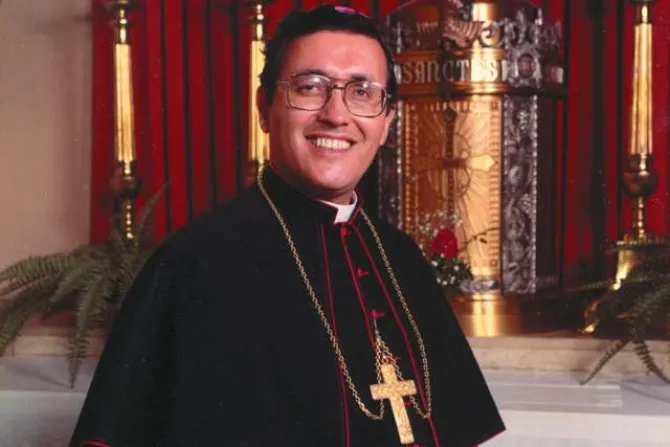Sacramento, Calif., Jul 15, 2016 / 11:02 am
On July 8 Pope Francis authorized the Congregation for the Causes of Saints to promulgate a decree recognizing the heroic virtues of Servant of God Alphonse Gallegos, who was auxiliary bishop of Sacramento from 1981 to 1991.
The late bishop is now called Venerable, and only one miracle worked through his intercession is needed before he can be beatified.
"This is wonderful news for all those who knew him," Fr. Eliseo Gonzalez, vice-postulator of Venerable Gallegos' cause of canonization, told CNA.
Fr. Gonzalez is a member of the Order of Augustinian Recollects, in which Bishop Gallegos was ordained a priest in 1958. Since the cause for canonization opened in December 2005, Fr. Gonzalez has been working to tell the bishop's story.
He explained that many people who knew Bishop Gallegos considered him a "living saint."
The bishop was born Feb. 20, 1931 in Albuquerque, New Mexico, and was the eighth of 11 children. His mother and father, Caciana and Joseph Gallegos, were very pious, according to testimonies collected for the canonization cause. The family prayed daily rosaries together and often had lessons on the catechism.
Bishop Gallegos was born with a "severe myopic condition" impacting his eyesight. Though he had many surgeries, the bishop's poor vision "remained chronic."
In an effort to seek "better educational opportunities for their children as well as medical treatment for him," Venerable Gallegos' parents moved the family to Los Angeles in the early 1930s.
It was there that Bishop Gallegos found his religious vocation. The family put down roots in an area known as "Watts", and they began attending San Miguel parish, which was run by the Order of Augustinian Recollects. Bishop Gallegos began "nurturing a deep desire to follow the religious life."
Venerable Gallegos entered the Order of Augustinian Recollects as a novice in 1950. A year later, he professed his first vows, and his solemn vows three years later.
"His visual handicap, however, limited his ability to read and to master all the study requirements for the advancement to the priesthood," his biography explained.
In 1954, Venerable Gallegos was moved to the order's major seminary, Tagaste Monastery, in Suffern, New York. But his vision worsened, making his studies more difficult. He had great difficulty reading his breviary so he was given a dispensation to pray the rosary instead.
"His situation was such that doubts were raised concerning his preparation for the priesthood," but he was ordained a priest May 24, 1958, given his holiness, humility, and community spirit.
Venerable Gallegos' ministry as a priest began at Tagaste Monastery. He spent eight years working with the neighboring hospitals and religious communities. After, he was appointed novice master for the Augustinian Recollects' Province of St. Augustine in Kansas City, Kansas. In 1972, he returned home to be pastor at his home parish in Watts.
The neighborhood was predominantly African-American and poor. Riots in the 1960s had left the area divided and filled with gangs, crime, and poverty. The priest made it his priority to focus on the local children, greeting them daily at the parish's school.
On the weekends, Venerable Gallegos would spend time with the lowriders of the community, blessing their cars and encouraging the Hispanic youth to pursue a college education. He also took care of the elderly and opened his home to anyone in need. He later served at Cristo Rey parish.
(Story continues below)
Word spread of his service, and in 1979 Venerable Gallegos was appointed director of the newly-created Hispanic affairs office of the California Catholic Conference. In this role he worked with bishops in both northern Mexico and California on such issues as immigration and evangelization. His work there led to his appointment as auxiliary bishop of Sacramento in 1981.
"He was Hispanic, yet he ministered to a very diverse group of people," Olympia Nunez, Venerable Gallegos' long-time secretary, told CNA.
"We had a Korean community, Chinese, African-American, Hispanic, and he was the person in charge of all these groups."
Nunez said the bishop was incredibly kind and outgoing, and never complained about his disability.
"Once a year for his birthday, everyone got together and celebrated with different ethnic foods and customs," Nunez reflected. "He brought all these people together."
The bishop's episcopal motto was "love one another." He advocated for the culture of life, and personally paid Catholic school tuition for the poor.
Fr. Gonzalez called Bishop Gallegos an inspiration and example of hope and fortitude for all.
"If he was able to accomplish such great things, why can't we? With God's help we can also accomplish great things."
On Oct. 6, 1991, Bishop Gallegos and his driver were returning home from Gridley, about 60 miles north of Sacramento. They had car troubles, so the two got out and started pushing the car to the side of the road. Another vehicle, driving in the same direction, struck the bishop.
More than 2,000 people were present at his funeral, and lowriders formed one of the longest funeral processions ever documented.
In addition to his pastoral concern for the poor, Venerable Gallegos was known for his commitment to the culture of life. He had been at a gathering in Gridley to pray the rosary for an end to abortion the day he died.
With the announcement of the bishop's cause advancing, Nunez said: "He doesn't belong to just Sacramento or California, he now belongs to the United States in general, and to the world, as an example of a good, humble, generous human being."
In order for him to be canonized, two miracles through the intercession of Venerable Alphonse Gallegos must be verified.
The faithful are encouraged to visit Venerable Alphonse Gallegos' body at Our Lady of Guadalupe Church in downtown Sacramento, his life-size statue in Bishop Gallegos Square, and a mini-museum displaying the bishop's personal items in Oxnard, some 65 miles west of Los Angeles.
Update: July 21, 2016 Minor corrections added throughout.


